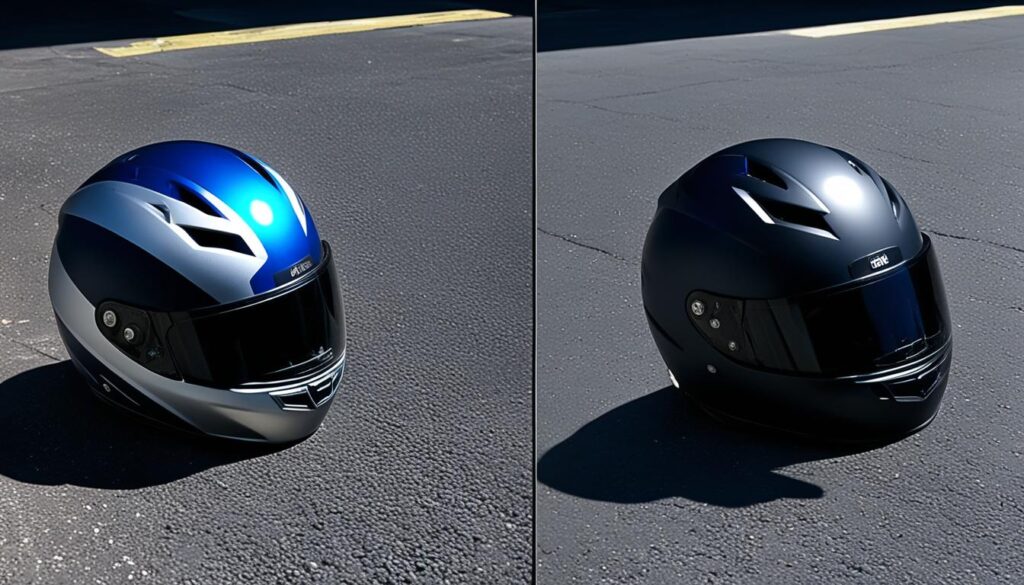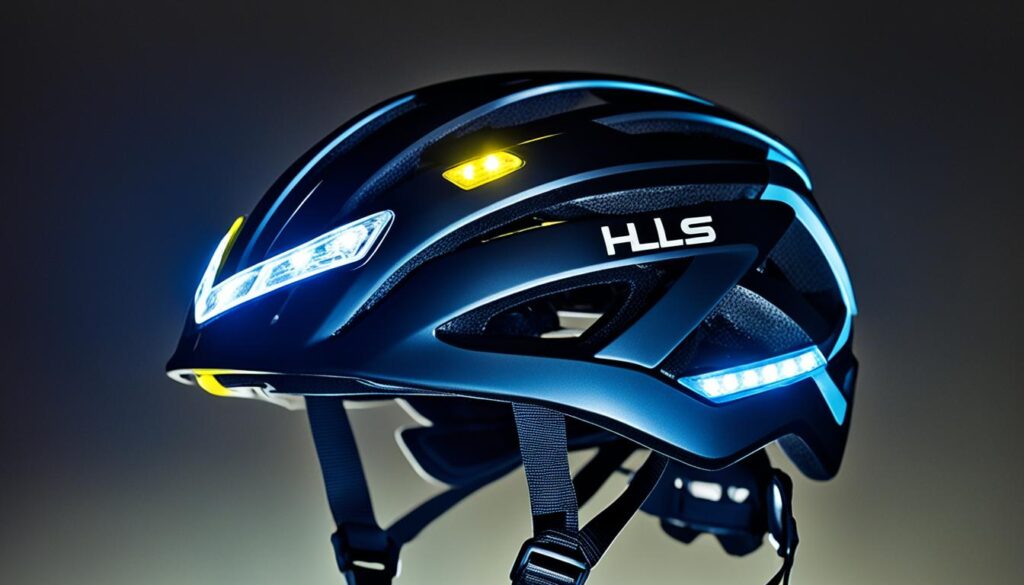
Have you ever wondered why some helmet camera videos look crystal clear and visually stunning, while others appear grainy and hard to decipher? The secret lies in the power of lighting. Whether you’re an adrenaline-seeking athlete capturing your extreme sports adventures or a motorcycle police officer recording your patrols, understanding the impact of lighting on your helmet camera footage is essential to achieving high-quality videos with maximum visibility and clarity.
Helmet cameras are designed to withstand the harshest conditions and provide an immersive experience by capturing the user’s field of view. But without proper lighting, even the most advanced helmet cameras can produce lackluster results. So, how exactly does lighting affect your helmet camera footage? And what are the best lighting techniques to optimize video quality and visibility?
Key Takeaways:
- The right lighting can greatly enhance the clarity and quality of your helmet camera footage.
- Poor lighting conditions can result in grainy, unclear, and hard-to-see videos.
- Using external lighting sources and adjusting camera settings are effective ways to improve visibility and video quality.
- Experimenting with lighting angles and positions can bring more dynamism and visual appeal to your footage.
- Optimizing lighting techniques is crucial for capturing stunning visuals that accurately depict your experiences.
The First-Person Gaze and Machine Gaze in Helmet Camera Footage
Helmet cameras offer a unique perspective that enables viewers to experience the world through the eyes of the user. The camera, mounted on the helmet, captures the user’s field of view, presenting a subjective shot that closely replicates what the user sees. This perspective is known as the first-person gaze, allowing viewers to immerse themselves in the recorded footage.
However, it is important to note that helmet camera footage differs from traditional point-of-view shots in film theory. While these shots typically incorporate the user’s body and contextual elements, helmet camera footage often lacks these components. As a result, the gaze presented through helmet camera footage is anonymous, portrayed from an unidentified subject.
The prosthetic nature of helmet camera perspective is a significant factor to consider. The camera itself becomes an extension of the user’s body, as it is securely attached to the helmet. This attachment emphasizes the machine gaze, highlighting the camera’s role as a mediating device that actively shapes the viewer’s perception of the recorded environment.
The Influence of Helmet Camera Field of View
A crucial element in understanding the first-person gaze and machine gaze in helmet camera footage is the field of view provided by the camera. The field of view determines the extent of the visual information captured by the camera, impacting the viewer’s immersion and perception of the recorded scene. A wider field of view allows for a broader perspective, potentially enhancing the viewer’s sense of presence and engagement with the footage.
On the other hand, a narrower field of view may result in a more focused and intimate experience, emphasizing specific details within the user’s line of sight. The choice of field of view depends on the desired effect and the narrative intention of the captured footage.
| Field of View | Description | Application |
|---|---|---|
| Wide | Captures a broad field of view, providing a comprehensive perspective | Scenic shots, action sequences |
| Narrow | Focuses on specific details, creating a more immersive experience | Intense moments, personal interactions |
As filmmaker and camera operators experiment with different field of view settings, they can shape the viewer’s perception and emotional response to the recorded footage. This versatility allows for a diverse range of storytelling possibilities and artistic expression.
The first-person gaze offered by helmet camera footage provides a unique way of experiencing the recorded environment, immersing viewers in the action and enabling them to witness events from the user’s perspective. However, it’s important to recognize that the absence of the user’s body and context adds an anonymous quality that can heighten the sense of detachment. Understanding the intricacies of the first-person gaze and machine gaze in helmet camera footage opens up possibilities for narrative experimentation and exploration of subjective perspectives in visual storytelling.
Importance of Helmet Lighting System (HLS) for Visibility and Safety
Motorcycle police officers and Highway Patrol play a vital role in ensuring the safety of our roads. However, their visibility during patrols and emergencies can be a concern, especially in low light conditions. That’s where the Helmet Lighting System (HLS) comes in. This innovative technology is specifically designed to enhance visibility and provide an added layer of safety on the road.
The HLS consists of wireless brake lights installed on the rear of the officer’s helmet. These lights automatically activate when the officer slows down or applies the brakes, alerting other drivers behind them. Additionally, the HLS includes high-intensity LED emergency lights that are activated when the officer engages the vehicle’s emergency lights. This ensures that the officer is visible from a distance, even in challenging weather or nighttime conditions.

The HLS is not limited to motorcycle police officers and Highway Patrol. Its versatility allows it to be used on other vehicles as well. Snowmobiles, equestrian mounts, and bicycles can also benefit from the increased visibility provided by the HLS. By improving visibility, the HLS enhances safety for riders of all kinds of vehicles, minimizing the risk of accidents and promoting overall road safety.
The HLS performs a similar function to a car’s third brake light, which has been proven to increase visibility and reduce the likelihood of rear-end collisions. By incorporating this technology into the helmets of motorcycle police officers and other vehicles, the HLS provides an effective safety solution that can make a significant difference on our roads.
| Benefits of Helmet Lighting System (HLS) | Applications |
|---|---|
| Enhances visibility for motorcycle police officers | Motorcycle police officers |
| Increased safety for Highway Patrol | Highway Patrol |
| Improved visibility for snowmobile riders | Snowmobiles |
| Enhanced safety for equestrian mounts | Equestrian mounts |
| Increased visibility for cyclists | Bicycles |
With the Helmet Lighting System (HLS), motorcycle police officers and Highway Patrol can rely on enhanced visibility during their patrols, leading to a safer working environment. The HLS also benefits other riders, ensuring they too can be seen on the road, particularly in challenging lighting conditions. By investing in technologies like the HLS, we prioritize safety and protect those who serve and ride on our roads.
Enhancing Helmet Camera Footage with Lighting Tips
To improve the quality and visibility of your helmet camera footage, it is crucial to employ effective lighting techniques. In this section, we will explore some valuable tips to enhance your videos and capture stunning visuals.
1. Ensure Adequate Lighting Conditions
Recording in low light environments can result in poor video quality. Therefore, it is essential to ensure sufficient lighting during your helmet camera sessions. Natural light or well-lit areas provide optimal conditions for capturing clear and detailed footage.
2. External Lighting Sources
Consider using external lighting sources to enhance the visibility of your scene. Auxiliary lights or camera-mounted LED lights can provide additional illumination and improve the overall quality of your footage. These lights help compensate for low light situations and ensure that important details are properly captured.
3. Camera Settings Optimization
Adjusting your camera settings can significantly impact the exposure and color accuracy of your footage. Experiment with settings such as ISO, shutter speed, and white balance to optimize the overall video quality. These adjustments allow you to adapt to different lighting conditions and ensure consistent and vibrant footage.
4. Experiment with Lighting Angles and Positions
Exploring different lighting angles and positions can add depth and visual interest to your helmet camera footage. Try capturing shots from various perspectives to create more dynamic visuals. By experimenting with lighting techniques, you can highlight specific elements or create intriguing shadows and contrasts in your videos.

Remember, the specific lighting techniques may vary depending on your camera model and its capabilities. Consider exploring your camera’s manual or consulting online resources for further guidance on optimizing your helmet camera footage.
Conclusion
In conclusion, the impact of lighting on helmet camera footage is significant, as it directly affects the clarity and quality of the recorded videos. Understanding the importance of proper lighting techniques is essential for optimizing helmet camera video quality and enhancing visibility.
Whether it is in the context of military operations or recreational motorcycle riding, the impact of lighting on helmet camera footage cannot be ignored. By implementing effective lighting strategies, users can greatly enhance the visual appeal and informational value of their recorded videos.
Helmet camera footage clarity is greatly influenced by the use of appropriate lighting. Low light environments can result in poor video quality, making it crucial to ensure adequate lighting conditions during recording. By utilizing external lighting sources, adjusting camera settings, and experimenting with different lighting angles and positions, users can ensure optimal results and capture stunning visuals that accurately represent their experiences.
By considering the tips and techniques discussed in this article, users can optimize their helmet camera footage and achieve exceptional video quality. The impact of lighting on helmet camera footage cannot be understated, as it directly affects the visibility and overall quality of the recorded videos.
Source Links
- https://contest.techbriefs.com/2016/entries/automotive-transportation/6780
- https://necsus-ejms.org/first-person-war-helmet-cameras-between-testimony-and-performance/
- https://motorcyclistattorney.com/motorcycle-helmet-camera-footage-is-it-admissible-in-court/

Meet James Smith, affectionately known by friends as ‘Biker Smith’, your go-to expert at ‘Best HD Helmet Camera’. At 35, living in the USA, James embodies the spirit of adventure. His life is a thrilling ride, powered by his Harley Davidson Softail and BMW S 1000 RR, with his girlfriend as his favorite travel companion. A software developer by profession, James’s heart beats for the open road, making him a full-time traveler at heart. His passion for biking and technology merges seamlessly on this platform. Recognizing a gap in discussions around helmet cameras, he founded this blog to educate and inspire fellow enthusiasts. His mission? To elevate your riding experience with the best HD helmet camera insights, backed by firsthand experiences, rigorous testing, and a genuine love for the ride. Trust James to guide you through the world of helmet cameras, where quality, innovation, and safety ride together.